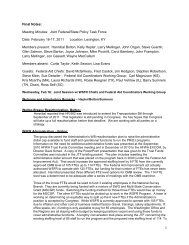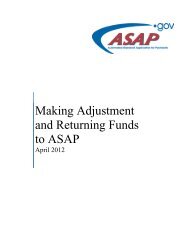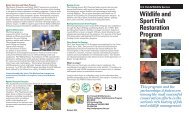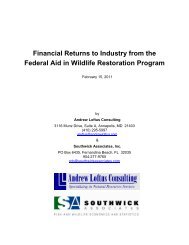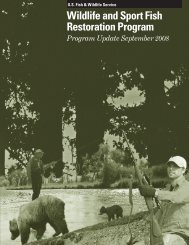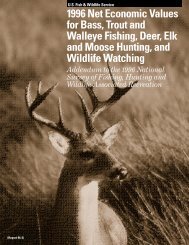May 20-21 - Wildlife and Sport Fish Restoration Program
May 20-21 - Wildlife and Sport Fish Restoration Program
May 20-21 - Wildlife and Sport Fish Restoration Program
You also want an ePaper? Increase the reach of your titles
YUMPU automatically turns print PDFs into web optimized ePapers that Google loves.
Meeting Notes<br />
Joint Federal/State Task Force on Federal Assistance Policy (JTF)<br />
Meeting Date: <strong>May</strong> <strong>20</strong>-<strong>21</strong>, <strong>20</strong>13<br />
Location: Minneapolis, MN<br />
JTF Co-chairs:<br />
AFWA Contact:<br />
USFWS Contact:<br />
JTF Members:<br />
Legal Counsel:<br />
Guests:<br />
Kelly Hepler (ADFG) <strong>and</strong> Hannibal Bolton (USFWS)<br />
Ashley Salo, AFWA, Multistate Conservation Grants Coordinator<br />
Joyce Johnson, Special Assistant for <strong>Program</strong> Development <strong>and</strong> Analysis<br />
Gary Armstrong, Lisa Evans, Wayne MacCallum, Steve Barton, Jon<br />
Gassett, Thomas Barnes, Larry Voyles, Joyce Johnson, Curtis Taylor<br />
Carol Bambery <strong>and</strong> Larry Mellinger<br />
John Frampton, Sherry Crouch, Jim Hodgson<br />
Action Item: Joyce Johnson, Lisa Evans, <strong>and</strong> Kelly Hepler will create a document detailing the<br />
process on how to bring forward <strong>and</strong> process issues through the JTF for distribution to state<br />
Directors, Federal Aid Coordinators, <strong>and</strong> Regional Chiefs by June 30, <strong>20</strong>13.<br />
Action Item: Chairman Curtis Taylor will work with Ron Regan (AFWA) to determine if an<br />
existing work group that was appointed by President Jeff Vonk would be the appropriate body to<br />
assist the JTF with concerns of the National Survey (current strengths, weaknesses, <strong>and</strong> potential<br />
long-term funding solutions). Curtis Taylor will work with President Jeff Vonk on this issue.<br />
Action Item: Steve Barton, Tom Barnes, <strong>and</strong> Hannibal Bolton will add the portion of the JTF<br />
minutes to the guidance document on TRACS summarizing the agreement between the Service<br />
<strong>and</strong> the JTF on state wildlife agencies authority to manage the information added <strong>and</strong> displayed<br />
in public TRACS by next JTF meeting.<br />
Action Item: Lisa Evans, Joyce Johnson, John Organ, <strong>and</strong> Gary Armstrong will draft a memo<br />
from the JTF Co-Chairs based on the white paper findings regarding the eligible use of PR/DJ<br />
funds for recruitment <strong>and</strong> retention programs/projects for distribution by June 15, <strong>20</strong>13.<br />
Action Item: Tom Barnes <strong>and</strong> Steve Barton will develop a document that presents options on<br />
how to count people who hold senior/multiyear licenses in the annual license certification. The<br />
document will explain the legal <strong>and</strong> historical background of the issue <strong>and</strong> the pros <strong>and</strong> cons of<br />
each option. The JTF Cochairs will review the document <strong>and</strong> approve it for sending to the<br />
Federal Aid Coordinators Working Group to request review <strong>and</strong> comment. Tom Barnes <strong>and</strong><br />
Steve Barton will consult with the Cochairs as to whether any changes are needed based on the<br />
working group’s comments. They will finalize the document for discussion by the JTF at the<br />
November <strong>20</strong>13 meeting. The document will then be distributed to state Directors for review<br />
<strong>and</strong> comment.<br />
Action Item: Hannibal Bolton/Paul VanRyzin will discuss FWS/State review of SWAP process<br />
at Chiefs meeting in October <strong>20</strong>13.<br />
Action Item: Hannibal Bolton will discuss SHPO coordination with Chiefs by June 15, <strong>20</strong>13.<br />
1
Monday <strong>May</strong> <strong>20</strong>th<br />
1. Welcome <strong>and</strong> Introductory Remarks (8:00am) – Bolton/Hepler<br />
2. Process to bring forward, analyze <strong>and</strong> resolve issues through the JTF <strong>and</strong><br />
Communication with AFWA/FWS/State Directors/Regional Chiefs – Kelly Hepler/Lisa<br />
Evans/Gary Armstrong/Joyce Johnson<br />
<br />
<br />
<br />
<br />
<br />
<br />
<br />
<br />
<br />
Summary of the previous JTF process: The process to bring forward, analyze <strong>and</strong><br />
resolve issues through the JTF previously involved sending out an initial poll to state<br />
directors soliciting any state or regional issues that needed to be addressed. Issues<br />
which appeared to be consistently misapplied nationally would be vetted through a<br />
small working group who would develop a white paper on those issues with possible<br />
solutions <strong>and</strong> recommendations. The white paper would then be brought forward <strong>and</strong><br />
reviewed by the JTF. After being finalized by the JTF, the white paper with is<br />
recommendations would be distributed to the state directors <strong>and</strong> regional chiefs for<br />
review <strong>and</strong> comments. The next JTF meeting would involve finalizing the<br />
recommendations <strong>and</strong> developing new policy.<br />
This was a consistently thorough process which helped address many national issues<br />
facing the state directors, chiefs, regions, federal aid coordinators, etc. The further<br />
the JTF has deviated from this original process, the more questions have come up.<br />
Need to have a clear <strong>and</strong> well defined process to vet the issues which are discussed<br />
<strong>and</strong> addressed by the JTF.<br />
Larry Voyles, Director AZ Game <strong>and</strong> <strong>Fish</strong>, is currently looking into compliance<br />
issues.<br />
Communication among JTF members, state directors, regional chiefs, federal aid<br />
coordinators is a key missing item in the current process which is raising questions<br />
such as: why does the JTF exist?<br />
The current minutes from the JTF meetings are being distributed to the state directors<br />
through AFWA’s DL. This is helping to address some of the communication barriers.<br />
The JTF needs to formalize <strong>and</strong> document the process for clarity.<br />
Each region should have a contact list of federal aid coordinators. This would be the<br />
ideal way to disseminate a document on JTF’s process to them.<br />
This information can also be discussed <strong>and</strong> disseminated to the state directors during<br />
the directors’ retreat.<br />
Action Item: Joyce Johnson, Lisa Evans, <strong>and</strong> Kelly Hepler will create a document detailing the<br />
process on how to bring forward <strong>and</strong> process issues through the JTF for distribution to state<br />
Directors, Federal Aid Coordinators, <strong>and</strong> Regional Chiefs.<br />
3. WSFR Updates – Steve Barton<br />
2
The 2 nd quarter receipts are in for <strong>Wildlife</strong> <strong>Restoration</strong>. Total receipts are at $354<br />
million. Already 103 million dollars ahead of this time in <strong>20</strong>12. Expecting this year<br />
to be another “bump” year.<br />
329.6 million for firearm <strong>and</strong> ammo receipts. The ammo component is up roughly<br />
30% from last year.<br />
FY12 receipts for <strong>Sport</strong> <strong>Fish</strong> <strong>Restoration</strong> was up significantly in August <strong>and</strong><br />
September, however, hit a correction in March <strong>and</strong> the net excise taxes was minus <strong>20</strong><br />
million dollars.<br />
o The most recent National Survey showed an increase in angling but most<br />
states saw a decrease in rods <strong>and</strong> reels, fishing licenses, etc. This is continuing<br />
evidence that the most recent National Survey has major data holes.<br />
o Staff are researching new mechanisms to reach survey participants, i.e. cell<br />
phones, mailing etc. Were unaware of an issue before the survey was rolled<br />
out.<br />
o A number of states noted an issue with the validity of the most recent National<br />
Survey.<br />
o There are many different variables with the National Survey. The survey looks<br />
at participation, not at receipts.<br />
o There are issues with the survey, which are being addressed by staff. But<br />
there is more to the data than simply comparing the participation numbers<br />
indicated with the excise tax receipts. Many of the issues deal with the sample<br />
size <strong>and</strong> the FWS ability to reach survey participants. Need to work to<br />
address this issue while staying within the current cost of the survey.<br />
o Need to convey the information to State Directors regarding the timeline of<br />
the National survey compared to the information received by the excise tax<br />
receipts.<br />
Action Item: Chairman Curtis Taylor will work with Ron Regan (AFWA) to determine if an<br />
existing work group that was appointed by President Jeff Vonk would be the appropriate body to<br />
assist the JTF with concerns of the National Survey (current strengths, weaknesses, <strong>and</strong> potential<br />
long-term funding solutions). Curtis Taylor will work with President Jeff Vonk on this issue.<br />
The amount determined for sequestration for the <strong>Wildlife</strong> <strong>and</strong> <strong>Sport</strong> <strong>Fish</strong><br />
<strong>Restoration</strong> programs is based off the President’s budget.<br />
The amount sequestered is currently sitting in the trust fund account <strong>and</strong> will be<br />
available for apportionment in <strong>20</strong>14. The fixed amounts (ex: multistate grant<br />
program) will not receive the funds which were sequestered. These funds will go<br />
to the states<br />
The <strong>Sport</strong> <strong>Fish</strong> <strong>Restoration</strong> sequestration amount was 4.69%.<br />
Need to be careful with the messages we are disseminating to the sportsmen<br />
regarding sequestration. On the one h<strong>and</strong>, they are being told that Congress had<br />
no right to sequester the funds. They are also being told that it doesn’t matter that<br />
the funds were sequestered because the funds are at an all-time high.<br />
For the first time State <strong>Wildlife</strong> Grant program received a preliminary<br />
apportionment.<br />
3
FWS is now in the normal phase of ASAP <strong>and</strong> FBMS. Should not expect the<br />
same initial delays in grant processing when FBMS was first rolled out.<br />
September 24 th –October 1 <strong>20</strong>13 ASAP blackout.<br />
Currently working with seven states with assent legislation concerns.<br />
o Funds need to be in control of state fish <strong>and</strong> wildlife agencies.<br />
o FWS faces 5-10 assent legislation issues every year.<br />
o These issues happen outside the control of the state agencies. This is<br />
legislation that is being done to the states.<br />
Had spring combined meeting with regional chiefs/federal aid coordinators in<br />
April <strong>20</strong>13.<br />
o Will travel be authorized for federal aid chiefs to travel to the federal aid<br />
coordinator meeting? FWS: Yes. This is in line with the critical mission<br />
of the FWS.<br />
Financial assistance wiki will be released to the public in late June. The website<br />
for the wiki is: fawiki.fws.gov.<br />
TRACS has the beta version released in March. All of the WSFR staff have been<br />
trained. State training began in Denver <strong>and</strong> Alaska. Have received positive<br />
responses from the training. Production version will be released later this month.<br />
Initial production release will have 3 of the 9 initial modules. It will take<br />
approximately 12 months, at the existing staffing levels to complete the initial 9<br />
modules.<br />
No policy issues have arisen from the beta testing.<br />
The last item that needs to be completed is adding a disclaimer to the public<br />
TRACS website.<br />
Guidance committee (consists of Federal Aid Coordinators, <strong>and</strong> State <strong>and</strong> Service<br />
staffs) has drafted a system guidance document for TRACS with questions <strong>and</strong><br />
answers. It follows all the general policies established in the JTF.<br />
The legacy data (FAIMS) is in the process of being converted to TRACS. Fair<br />
amount of time needed to get this accomplished.<br />
Information that is displayed in public TRACS will be a high level summary<br />
(summary of project, estimated cost, where the project is located, etc) <strong>and</strong> will be<br />
determined by state agencies not FWS. This information will be under the<br />
control <strong>and</strong> discretion of the states.<br />
States can also create tailored public TRACS websites.<br />
State agencies will have two licenses for their staff to access the TRACS program.<br />
If a state will need additional licenses then they will need to coordinate with<br />
Paladin not FWS. These licenses will be good for five years when the contract<br />
between FWS <strong>and</strong> Paladin is renegotiated.<br />
States will have unlimited licenses for data TRACS because this is a federal<br />
system which FWS will operate.<br />
L<strong>and</strong> acquisition projects in TRACS should be as detailed as possible. This<br />
information will be up to the discretion of the state agencies to determine how<br />
detailed they will be.<br />
It’s important to document the agreement made regarding the state wildlife<br />
agencies ability to determine what information will go into public TRACS.<br />
4
o Add this information in to the guidance document rather going through the<br />
process of creating a policy manual chapter.<br />
o Easiest way to accomplish this would be to add the JTF minutes to the<br />
guidance document.<br />
Biannual compliance audit is underway. First time having a compliance audit<br />
versus a fiscal audit.<br />
Tom Barnes has developed three real property chapters.<br />
Action Item: Steve Barton, Tom Barnes, <strong>and</strong> Hannibal Bolton will add the portion of the JTF<br />
minutes to the guidance document on TRACS summarizing the agreement between the Service<br />
<strong>and</strong> the JTF on state wildlife agencies authority to manage the information added <strong>and</strong> displayed<br />
in public TRACS by next JTF meeting.<br />
4. Eligible use of PR/DJ funds for recruitment <strong>and</strong> retention – JTF Action on Hunter Ed<br />
funding for archery programs – John Organ, Lisa Evans, Gary Armstrong, Joyce Johnson<br />
<br />
<br />
<br />
<br />
People are still being given inaccurate information regarding recruitment <strong>and</strong><br />
retention. The primary purpose of the white paper was to educate all the regions as<br />
well as many state agencies on the eligible uses of PR/DJ funds for recruitment <strong>and</strong><br />
retention efforts. The newly added attachment to the original white paper addresses<br />
the range of concerns expressed in order to fund Archery in the Schools or other<br />
similar programs.<br />
Need to determine if this information needs to be included in CFR.<br />
Could send the information out as a joint memo from the JTF co-chairs to state<br />
directors, federal aid coordinators, etc.<br />
Initial discussions on the topic could be held during the Industry-Agency summit on<br />
<strong>May</strong> 22-23 rd .<br />
Action Item: Lisa Evans, Joyce Johnson, John Organ, <strong>and</strong> Gary Armstrong will draft a memo<br />
from the JTF Co-Chairs based on the white paper findings regarding the eligible use of PR/DJ<br />
funds for recruitment <strong>and</strong> retention programs/projects for distribution.<br />
5. Feasibility <strong>and</strong>/or necessity of conducting a national WSFR customer satisfaction<br />
survey – Kelly Hepler, Lisa Evans, Joyce Johnson<br />
<br />
<br />
<br />
Do not currently have the funding to conduct a national WSFR customer satisfaction<br />
survey.<br />
The cost of the potential survey would be approximately $40-50,000 dollars. The<br />
same results could be achieved through a JTF poll.<br />
Recommend not conducting a national WSFR customer satisfaction survey at this<br />
time.<br />
6. Update on WSFR L<strong>and</strong>s Chapters <strong>and</strong> other ongoing FA Policy Issues – Tom Barnes<br />
5
There are two basic processes in policy: 1) regulation: communicate to states what<br />
they have to do in order to comply with law <strong>and</strong> 2) Service manual chapters where<br />
the Director gives instructions to Service employees.<br />
A Service Manual chapter can indirectly affect a grantee because the Director can<br />
instruct a Service employee to award a grant subject to a specific term or condition.<br />
Currently responsible for 38 manual chapters published for Service. State agencies<br />
often use these chapters to help with communication with Service employees.<br />
The 38 chapters date all the way back to 1992. Many of them are outdated <strong>and</strong> need<br />
to be restructured or removed.<br />
There are three sets of program regulations: 50 CFR 80 for the <strong>Wildlife</strong> <strong>Restoration</strong>,<br />
<strong>Sport</strong> <strong>Fish</strong> <strong>Restoration</strong>, <strong>and</strong> Hunter Education grant programs; 50 CFR 85 for the<br />
Clean Vessel Act grant program; <strong>and</strong> 50 CFR 86 for the Boating Infrastructure Grant<br />
program.<br />
The National Coastal Wetl<strong>and</strong>s Conservation Grant program primarily falls under the<br />
Assistant Director for <strong>Fish</strong>eries <strong>and</strong> Habitat Conservation.<br />
The goal is to reduce the number of chapters from 38 to 9.<br />
Will take information that belongs in regulation <strong>and</strong> will put it in 50 CFR 80 or the<br />
planned 50 CFR 75. The regulations in 50 CFR 75 would be applicable to grant<br />
programs as a whole.<br />
There are 12 chapters significantly out of date (1992-<strong>20</strong>01).<br />
We have only one real property chapter right now which was written in 1992. It is out<br />
of date <strong>and</strong> does not go into enough detail to ensure nationwide consistency.<br />
Have distributed three draft chapters on real property for comments to Chiefs in<br />
February. In the process of addressing the three issues which were raised from the<br />
comments. Once the issues have been addressed, the chapter will be distributed to<br />
states, regional offices, <strong>and</strong> the JTF for a 90-day comment period.<br />
In 1970 Congress passed the Uniform Relocation Assistance <strong>and</strong> Real Property<br />
Acquisition Policies Act. In 1971, the Department of Justice developed the Uniform<br />
Appraisal St<strong>and</strong>ards for Federal L<strong>and</strong> Acquisition, which are commonly called the<br />
yellow book st<strong>and</strong>ards.<br />
In developing the final versions of the real property chapters, we will review the U.S.<br />
Forest Service’s Forest Legacy program to determine if any of its policies would be<br />
appropriate for l<strong>and</strong> acquisition in our grant programs.<br />
New chapters will include information on: qualification st<strong>and</strong>ards for review<br />
appraisers, when costs are incurred, title insurance, certificates of title, criteria for use<br />
of waiver valuation, buying l<strong>and</strong> at an auction, the ineligibility of endowment funds<br />
for monitoring <strong>and</strong> enforcement of conservation easements, etc.<br />
We will consult with the JTF before initiating any revisions of Service Manual<br />
chapters 522 FW 16–25, which are based on the JTF’s recommendations during<br />
<strong>20</strong>03–05.<br />
An appendix to Chapter 8 will detail every step in l<strong>and</strong> acquisition that requires prior<br />
approval.<br />
7. State Certification – multiyear licenses (includes senior/Lifetime/bundled)– Steve Barton<br />
6
50 CFR 80.10 : (3) Licenses valid for more than one year, either a specific or<br />
indeterminate number of years, may be counted in each of the years for which they<br />
are valid; provided that:<br />
o (i) The net revenue from each license is commensurate with the period for<br />
which the hunting or fishing privileges are granted; <strong>and</strong><br />
o (ii) Sampling or other techniques are used to determine whether the licensee<br />
remains a license holder in year of certification<br />
Commensurate was added in 1974.<br />
The following additional requirements apply to multiyear licenses:<br />
o A multiyear license may be valid for either a specific or indeterminate number<br />
of years, but it must be valid for at least 2 years.<br />
o The agency must receive net revenue from a multiyear license that is in close<br />
approximation to the net revenue received for a single-year license providing<br />
similar privileges:<br />
o Each year during the license period; or<br />
o At the time of sale as if it were a single-payment annuity, which is an<br />
investment of the license fee that results in the agency receiving at least the<br />
minimum required net revenue for each year of the license period.<br />
o An agency may spend a multiyear license fee as soon as the agency receives it<br />
as long as the fee provides the minimum required net revenue for the license<br />
period.<br />
o The agency must count only the licenses that meet the minimum required net<br />
revenue for the license period based on:<br />
o The duration of the license in the case of a multiyear license with a specified<br />
ending date; or whether the license holder remains alive.<br />
o The agency must obtain the Director's approval of its proposed technique to<br />
decide how many multiyear-license holders remain alive in the certification<br />
period. Some examples of techniques are statistical sampling, life-expectancy<br />
tables, <strong>and</strong> mortality tables.<br />
In order to allow some degree of discounting, the term “in close approximation to the<br />
net revenue” was added.<br />
Determine comparable annual license:<br />
o Interest Rate = Federal Funds Rate<br />
• Published by Federal Reserve<br />
• http://www.federalreserve.gov/releases/h15/data.htm<br />
• Average Interest Earnings Rate (1955–<strong>20</strong>12) = 5.284%<br />
o Life-Time Licenses<br />
• Use Social Security Administration Actuarial Life Table<br />
• http://www.socialsecurity.gov/OACT/STATS/table4c6.html<br />
• <strong>May</strong> Use Immediate Single-Payment Annuity Calculator<br />
• http://www.freeannuityrates.com/annuities/calculators/immediateannuity-calculator.php<br />
The Service could develop a survey, similar to what was done for recreational<br />
boating access with questions <strong>and</strong> answers on the background of the issue, <strong>and</strong><br />
options to resolve the issue. Each State agency could choose its preferred option.<br />
Need to determine a resolution here that makes sense for the states.<br />
7
o At the recommendation of FWS, South Carolina began charging for senior<br />
licenses (they were initially free). Were advised that they could count the<br />
senior license sold as a dollar a year for eight years. Now they are being told<br />
they cannot count these license which was a unilateral decision by the Service<br />
which cost South Carolina approximately $<strong>20</strong>0,000.<br />
o It would be beneficial to walk through the process of how these decisions<br />
were made to better underst<strong>and</strong> the process <strong>and</strong> what can be improved upon.<br />
o This information (language presented in 50 CFR 80.35) was vetted through<br />
the JTF. Additionally, FWS cannot anticipate every type of license that<br />
exists.<br />
o Need to better define “close approximation” for state licenses.<br />
o Intent of Congress was for these dollars to get to the states as fast as possible.<br />
There needs to be sufficient input from the states.<br />
o The JTF could consider charging a small working group to begin a dialogue<br />
on this issue. Need to know the starting point/bottom line.<br />
o AFWA President Jeff Vonk has assembled a small working group to<br />
determine if there’s a level playing field among states with the state licenses.<br />
This group was not asked to look into the senior license issue.<br />
o The JTF first needs to define what the problem is before it can be addressed..<br />
o We had defined license certifications to result in at least one dollar in net<br />
revenue. Why would it be switched to “a close approximation?”<br />
o The policy is set out in the regulation. It has to return a close approximation<br />
of what a single year license would have returned.<br />
o In the regulation, a multiyear license has to meet the minimum net revenue<br />
requirements for each year that the license is valid <strong>and</strong> in 50 CFR 80.35 it’s<br />
“net revenue … in close approximation to the net revenue received for a<br />
single-year license providing similar privileges.”.<br />
o States need to know if they need to fix their license certification <strong>and</strong> should<br />
have ample amount of time to address the concerns/issues.<br />
8. Small Groups convene –<br />
<br />
Small Group discussion: License Certification - Larry Mellinger (Chair), Sherry<br />
Crouch, Steve Barton, Gary Armstrong, Jim Hodgson, Joyce Johnson, Lisa Evans,<br />
Kelly Hepler, Tom Barnes, Hannibal Bolton, John Frampton<br />
o The guidance on 50 CFR 80.35 was widely circulated prior to<br />
implementation. There are options available to address the concerns which<br />
aren’t in conflict of the current regulation.<br />
o A license needs to return at least a dollar a year in order to be counted. If you<br />
read the constituents parts, it very much allows for having an annual senior<br />
license. When you calculate the number of years you’re going to count a<br />
lifetime senior license, as long as it counts the minimum return for a year<br />
you’re following the guidance.<br />
o What would you recommend on the special multiyear license?<br />
• A policy decision that would need to be made by the Service in<br />
consultation from the states.<br />
8
o The license revenue in the old rule had to be directly proportional/valid <strong>and</strong><br />
the only way to connect that was through the annual license.<br />
o Do we want to re-address the time period you count a multiyear license? What<br />
happens when the rule is changed?<br />
o Most legislation, at least on state level, is usually gr<strong>and</strong>fathered.<br />
o Other component on this issue is to make sure there is a level playing field<br />
among the states. Equivalent ability to count folks.<br />
o One particular problem with gr<strong>and</strong>fathering is the issue of how to interpret the<br />
rules from 1974 to <strong>20</strong>11. Even though the best interpretation was<br />
commensurate with the income of an annual license, it clearly was not the<br />
most common interpretation.<br />
o The Service should consult with the states on how to interpret the regulation.<br />
o States should have a couple of years to fix any issues if their interpretation<br />
will need to be changed.<br />
o Should have a small working group tackle this issue <strong>and</strong> develop a white<br />
paper.<br />
o The Service should identify reasonable options on how to comply with the<br />
law.<br />
o One of the options that needs to be considered is you cannot always write into<br />
policy every possible scenario or contingency.<br />
Action Item: Tom Barnes <strong>and</strong> Steve Barton will develop a document that presents options on<br />
how to count people who hold senior/multiyear licenses in the annual license certification. The<br />
document will explain the legal <strong>and</strong> historical background of the issue <strong>and</strong> the pros <strong>and</strong> cons of<br />
each option. The JTF Cochairs will review the document <strong>and</strong> approve it for sending to the<br />
Federal Aid Coordinators Working Group to request review <strong>and</strong> comment. Tom Barnes <strong>and</strong><br />
Steve Barton will consult with the Cochairs as to whether any changes are needed based on the<br />
working group’s comments. They will finalize the document for discussion by the JTF at the<br />
November <strong>20</strong>13 meeting. The document will then be distributed to state Directors for review <strong>and</strong><br />
comment.<br />
Tuesday <strong>May</strong> <strong>21</strong>st<br />
9. Small Groups Report Out on Identified Topics w/Recommendation(s) for action:<br />
-Small Group discussion: License Certification (Curtis Taylor, Larry Voyles, Jon<br />
Gassett, Carol Bambery)<br />
AFWA President Jeff Vonk has appointed a small working group through<br />
AFWA’s Executive Committee to evaluate the status of the license certification<br />
construct, from a state perspective, in terms of mechanisms used by states to<br />
generate or grow license sales <strong>and</strong> the impact, if any, on annual license<br />
certification <strong>and</strong> concomitant allocation of federal assistance dollars to the states.<br />
The bottom line is no matter how license certification is regulated states will<br />
be able to develop new ways to recruit <strong>and</strong> retain hunters <strong>and</strong> anglers. If the<br />
9
egulation is to be changed, data driven analysis of what the causes <strong>and</strong>/or<br />
benefits of new recruitment methods should be determined first.<br />
Is there a level playing field for states license certification? What was the<br />
original intent of the <strong>Wildlife</strong> <strong>and</strong> <strong>Sport</strong> <strong>Fish</strong> <strong>Restoration</strong> programs in regard to<br />
tactical distribution?<br />
There is a lack of clear definition for license certification which leaves states<br />
open for audits.<br />
Where does counting license become contrary to providing opportunity to<br />
recruit <strong>and</strong> retain hunters <strong>and</strong> anglers? Where is the line?<br />
Data should be reviewed first regarding the actual disparity among states<br />
versus perception before regulatory change should be considered.<br />
o This should be considered a policy call not a regulation change.<br />
Who would determine if the money benefiting one state is too much or too<br />
little?<br />
This is about participation in hunting <strong>and</strong> angling. The discussions have<br />
become centered on how states charge for certifications. The discussion needs to<br />
look at participation first. Need to first come up with a better way for states to<br />
increase participation.<br />
Need to go back <strong>and</strong> pull congressional record for intent. Participation was<br />
always at the center. It was a way to fund conservation. There was no vision of<br />
using licenses to recruit <strong>and</strong> retain hunters. Whatever future system is put into<br />
place states will try to maximize their benefit, however possible.<br />
There are significant amount of hunters <strong>and</strong> anglers paying money into the<br />
system, but their funds don’t count (ex: recreational shooters).<br />
o The National Survey should show changes in participation rates.<br />
A small group should calculate what the effects of using licenses to recruit<br />
<strong>and</strong> retain hunters <strong>and</strong> anglers. If the results are high enough policy change should<br />
be considered. This could be done between now <strong>and</strong> AFWA’s Executive<br />
committee meeting at the September annual conference. The Executive<br />
committee may then come forward with recommendations.<br />
The numbers should be reviewed by an economist. Past experience has<br />
shown that finding a price with many different variables will be extremely<br />
difficult.<br />
10
AFWA small working group will present to the AFWA Executive committee at<br />
AFWA’s annual conference in September <strong>20</strong>13. If a consensus cannot be reached<br />
during this meeting, the AFWA small working group will bring the issue forward<br />
to the JTF to review.<br />
10. FWS/State Review of SWAP – Kelly Hepler<br />
Regional team of state directors <strong>and</strong> an ARD review <strong>and</strong> approve state SWAP<br />
plans.<br />
Process should be clear for new ARDs (Ex: new ARD in Alaska).<br />
Action Item: Hannibal Bolton/Paul VanRyzin will discuss FWS/State review of SWAP process<br />
at Chiefs meeting in October <strong>20</strong>13.<br />
11. Working with Industry – Larry Voyles /Carol Bambery /John Frampton<br />
John Frampton has been working on industry coordination through a multistate grant.<br />
Some of the work being done includes the following:<br />
o Review the fairness in the application <strong>and</strong> enforcement of the excise tax<br />
among manufacturers <strong>and</strong> the first sales point in the U. S. through increased<br />
involvement by the Association of <strong>Fish</strong> <strong>and</strong> <strong>Wildlife</strong> Agencies with the Tax<br />
Fund Collection Work Group <strong>and</strong> through working with the Alcohol <strong>and</strong><br />
Tobacco Tax <strong>and</strong> Trade Bureau (ATTB) <strong>and</strong> the IRS (significant PR/DJ<br />
dollars are lost through internet sales).<br />
o Enhance the awareness of the essential value of the WSFR (<strong>and</strong> its connection<br />
to license revenues <strong>and</strong> assent language through proclamations, resolutions,<br />
orders or other means by governors, legislatures or commissions for at least<br />
90% of the states.<br />
o Enhance the “Tool Kit” developed for the 75th Anniversary Celebration of the<br />
WSFR <strong>and</strong> increase visibility of the WSFR at industry trade shows <strong>and</strong> special<br />
events. To obtain visible program opportunities at the trade functions<br />
including formal presentations at their events during key functions (breakfast,<br />
lunch or banquet events/press conferences; seminars).<br />
o Distribute WSFR educational messaging in product packaging, on industry<br />
web sites <strong>and</strong> on other forms of media utilized by industry partners in order to<br />
help br<strong>and</strong> <strong>and</strong> inform constituents <strong>and</strong> the public on the success <strong>and</strong> need for<br />
the WSFR.<br />
o Create a listing of all hunting, shooting, fishing, boating <strong>and</strong> related sporting<br />
industries in each state with appropriate contact information on key industry<br />
staff for each agency.<br />
o Video segments promoting the success <strong>and</strong> need for the WSFR will be<br />
developed <strong>and</strong> provided to the states, industry, NGOs, AFWA <strong>and</strong> CAHSS for<br />
use on their web sites <strong>and</strong> at events. The segments will be st<strong>and</strong>-alone videos<br />
promoting the WSFR <strong>and</strong> highlighting the value of the program utilizing<br />
spokespeople from industry, state <strong>and</strong> federal partners as well as celebrity<br />
individuals.<br />
o Assemble a strategic group of industry-state leaders (think tank) to<br />
recommend proactive measures that meet the future challenges to angling,<br />
11
oating, hunting <strong>and</strong> shooting. A broad scale underst<strong>and</strong>ing of the nature of<br />
the challenges <strong>and</strong> an agreement on solutions to enhance each activity will be<br />
developed.<br />
o Put state agency directors in touch with experts who can assist the agencies on<br />
best business practices (mining license information as an example). States<br />
need to better use their data base to further conservation <strong>and</strong> angler, hunter<br />
<strong>and</strong> shooting sports participation. Industry has staff or associates who can<br />
share this information with the states.<br />
A think tank with Industry members <strong>and</strong> state directors will take place prior to the<br />
Industry/Agency meeting in <strong>May</strong>.<br />
11. Parking lot, Related issues, <strong>and</strong> Meeting Wrap-up –Kelly Hepler/Hannibal Bolton<br />
Coordination with the State Historic Preservation Office (SHPO):<br />
o Alaska was recently approached by the regional FWS office to accept<br />
delegation of authority <strong>and</strong> was also told the FWS cannot accept State<br />
consultation with the SHPO as sufficient for the purposes of Tribal<br />
consultation or as the final determination to fulfill federal<br />
responsibilities of Section 106 of the National Historic Preservation<br />
Act. Discussions with the Regional WSFR office seem to indicate this<br />
change is happening across the nation.<br />
o Have any states accepted delegation? What has that meant for them in<br />
regards to grant costs? Have there been delays in grant processing for<br />
states who have not accepted delegation?<br />
o Methodologies have been developed in each FWS region which has<br />
not been consistent with historic preservation act. Therefore FWS is<br />
looking at the process nationally for a consistent WSFR policy.<br />
o If WSFR is developing new policy on this topic, the JTF should be<br />
involved in the process.<br />
o FWS is currently looking at if new policy assistance is needed first<br />
before policy will be changed/revised.<br />
Action Item: Hannibal Bolton will discuss SHPO coordination with Chiefs.<br />
Schedule for JTF Meetings:<br />
o November 6-7 th (5 th <strong>and</strong> 8 th travel days) <strong>20</strong>13; New Orleans, LA<br />
o April <strong>20</strong>14, possibly with annual Chief meeting; Denver CO<br />
12




